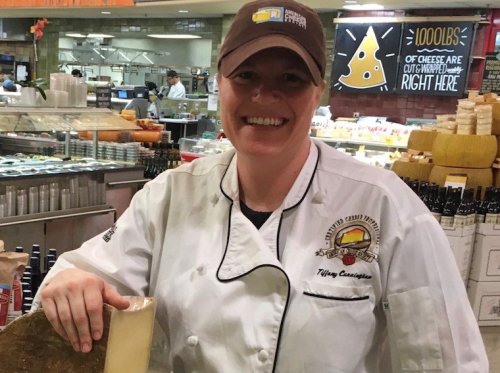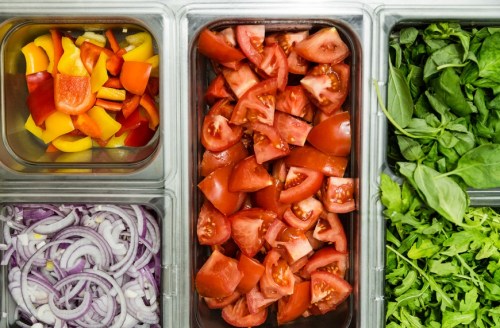Our editors independently select these products. Making a purchase through our links may earn Well+Good a commission
With 450 stores across the U.S.—including a whopping 80,000-square-foot flagship in Austin, Texas—Whole Foods is one of the most popular places for healthy eaters to stock up on organic foods and clean beauty products—and discover some pretty cool emerging brands as they shop. But, like with any chain, working at the store is a whole different experience than shopping there.
Have you ever walked in, glanced at the mega-long line, and wondered if there was a time of day when it let up? Or appraised the tower of avocados and speculated whether they ever went on sale? Tiffany Cunningham has been working with Whole Fods for almost 11 years, currently as a specialty team member at the flagship store. (She’s also a cheese professional, certified by the American Cheese Society.) In addition to having a front row seat to shoppers’ habits, she’s picked up on some pretty handy shopping tips, like knowing when the prices drop on certain items and how to save money at the grocery chain’s famous hot bar.
Here, Cunningham shares five things she’s learned while working at Whole Foods.
Scroll down to find out what it’s really like to work at Whole Foods.

1. You can avoid long lines by doing your shopping on Thursday nights
“The time when the lines are the shortest are either weekday mornings or Thursday nights,” Cunningham reveals. As you can probably guess, weekends are the busiest—especially Sundays. But Cunningham says there are some perks for coming during peek hours. “Weekends are when you’ll be able to sample the most things,” she says.
The takeaway here: When you’re in a hurry, skip the weekends. But if you don’t mind a leisurely day walking the aisles and discovering some potential new faves, Sunday is your fun day.

2. Checking the weekly sales before doing your meal-prep can save you cash
According to Cunningham, Whole Foods announces its sales for the week every Wednesday, and she plans her meal prep around this info to save money. “You can either see the sales online or in the stores, on sales fliers,” she says. And while Whole Foods might be pricer than the average supermarket, Cunningham says the store does have sales every day, including on produce and protein.
Another way to stay on top of deals is following the store on social media, where they push out alerts along with recipe inspo.

3. Take your shopping cues from the store’s most popular items
Ever wondered what the most popular item people buy is? “The 365 Everyday Value sparkling water is one of the most popular,” Cunningham says. (Her personal fave is the grapefruit flavor.) Something else that crosses the register pretty steadily all day: You guessed it—avocados.
As a cheese specialist, Cunningham is privy on customers’ preferences in that arena in particular. “Our most popular is parmigiano reggiano,” she says. “We work with specific producers and Italy and it’s aged 24 months, which is actually double the time required by law.”
Working the floor, she’s discovered her own personal finds, too. “One of the other team members recommended I try the 365 Everyday Value red enchilada sauce,” she says. “I did, and it’s so delicious. I use it at home on my enchiladas all the time.” In the produce department, she’s become a big fan of spiralized butternut squash and also pink lady apples. “There are so many different varieties of apples, but this one is really good and a bit tart,” she says.

4. For a cheapie lunch, gravitate toward greens
Putting together a meal from the hot bar may sound like a cheap and easy lunch, but if you’re not paying attention, it can add up quickly. “I’ve found that the salad bar can be pretty economical,” Cunningham says. “I fill my container up with mostly greens and that keeps it affordable.”
The stores also celebrate national “days”—AKA pizza day, hummus day, or world vegetarian day—so she recommends keeping an eye out for deals around these very important holidays. “They’re announced about a week out,” she adds.

5. The DIY spices and nut section is completely underrated
When it comes to buying spices, nut butters, and even olive oil, Cunningham has found that going to the self-serve section of the store can be the most cost-effective—and healthy. “A lot of people don’t realize that you can actually grind your own peanut butter, so it’s fresh, and then you only take home as much as you need,” she says. And bonus, you’ll also know there isn’t any added sugar or preservatives.
Speaking of grocery shopping intel, here are some mistakes even healthy people make when stocking up. But if the idea of food shopping fills you with dread, check out these options for healthy meal delivery.
Sign Up for Our Daily Newsletter
Get all the latest in wellness, trends, food, fitness, beauty, and more delivered right to your inbox.
Got it, you've been added to our email list.











